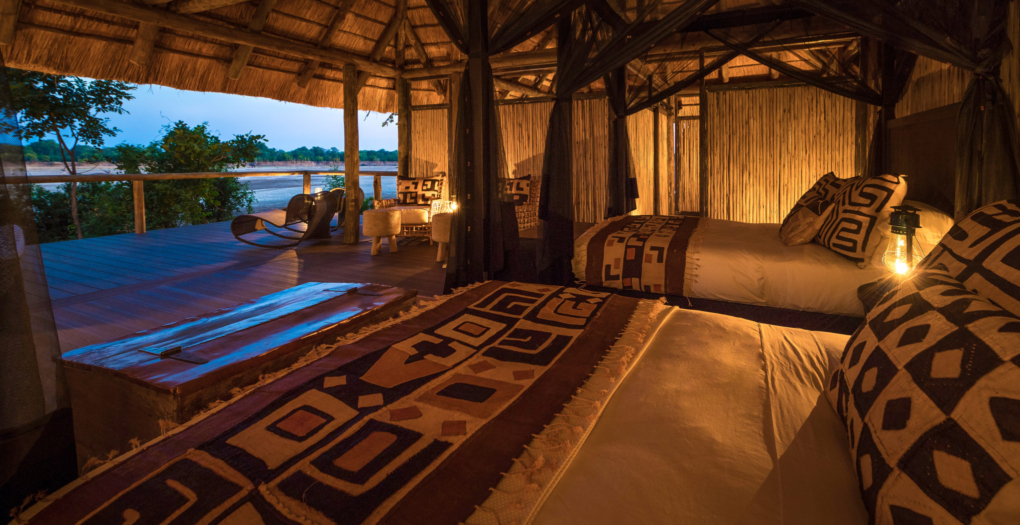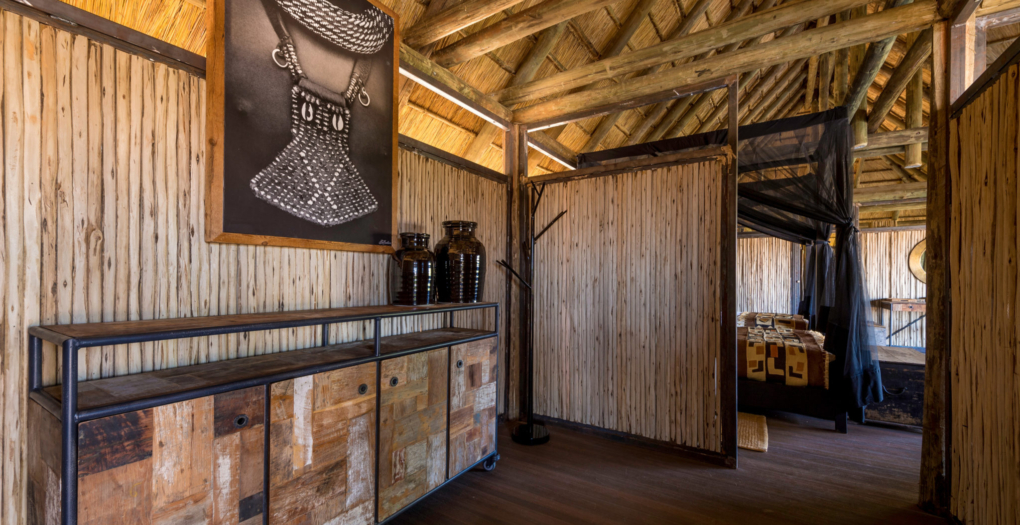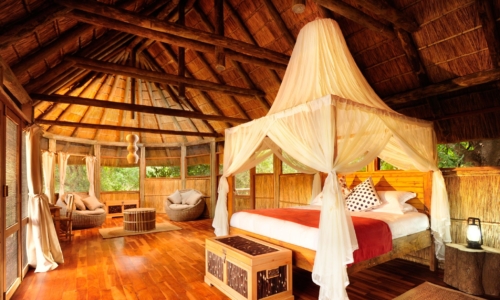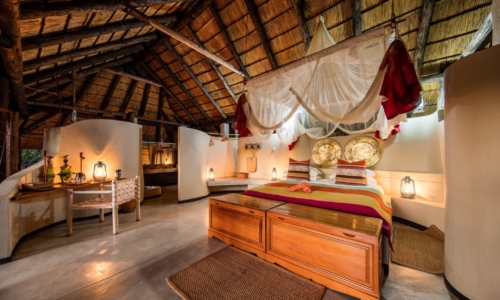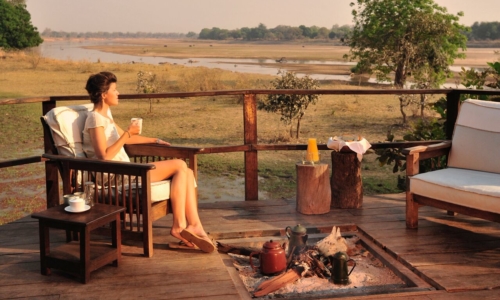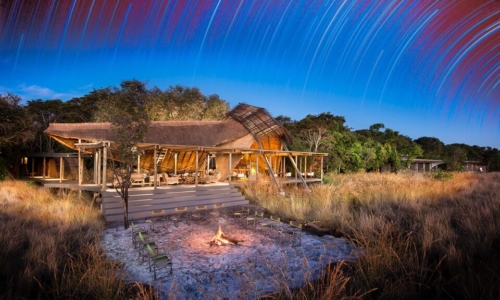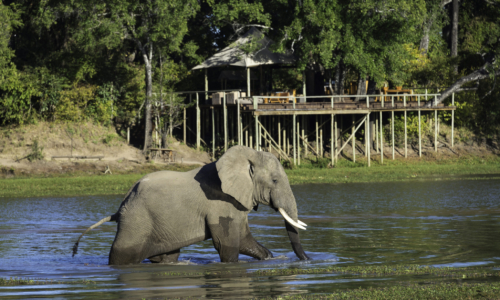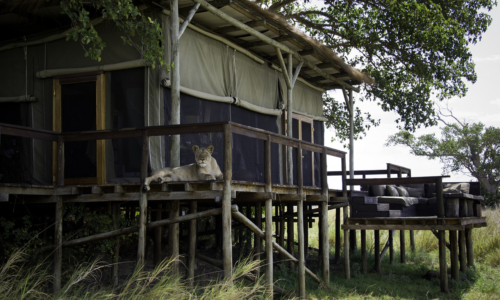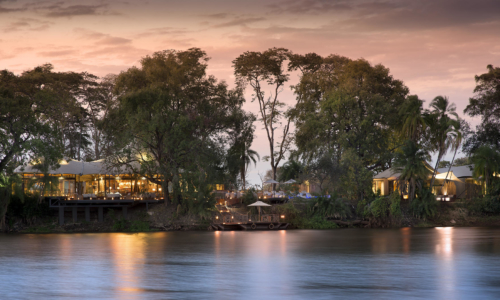Accommodations at the camp consist of only three stilted tree houses that can house up to six guests making it ideal for small groups. There are two twin chalets and one double chalet available. The chalets are open-fronted so guests can enjoy magnificent views of the river from their four-poster bed. The en suite bathrooms come with twin showers, twin vanities, and flush toilets. A private wooden deck in front of the bedroom is fitted with comfortable chairs and lies under the shade of giant ebony trees making it the perfect spot to relax and watch the wildlife wander by.
The camp is located in South Luangwa National Park, a world-famous wildlife haven, centered around the Luangwa River. Its historic virility stems from its topography. The Muchinga Escarpment forms the park’s western and northwestern boundaries, sloping steeply down to the river from the west side. The river valley, continued to the west by the Lunsemfwa River valley, forms a natural barrier, and to this day there are no man-made roads spanning the valley. The Park enjoys a dense animal population including Impalas, pukus, waterbucks, giraffes, and buffaloes grazing on the plains. A high number of leopards stalk the dense woodlands, while herds of elephants wade through the marshes and hippos play in the Luangwa River. There are about 400 bird species recorded in the Park.
As the rumored birthplace of the walking safari, the camp offers expertly guided walks led by an armed scout from the Zambian Wildlife Authority and a knowledgeable local guide. Not only is a waking safari the best way to take a closer look at the area’s flora and fauna, it also provides lessons on tracking animals by their spoor or how to use the juice of a sausage tree to soothe an insect bite. Daily game drives are conducted by expert trackers in 4×4 vehicles. Night drives use spotlights to discover the nocturnal antics of many animals missed during the day. Sundowners are served right on the river’s edge. The camp has a hide overlooking one of the seven oxbow lagoons behind the camp.
The main area of camp includes a thatched bar, dining area, and lounge. A wide veranda comes with comfortable loungers and chairs making it the best spot to watch the animals at the river with a drink in hand. The camp is open from June to November. An environmentally-friendly property, the camp uses solar heated water as well as solar powered and paraffin lamps.

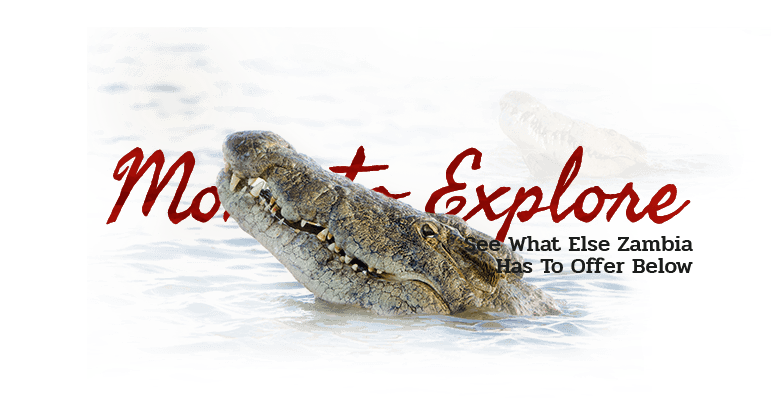
- Baines’ River Camp
- Bilimungwe Bushcamp
- Busanga Bush Camp
- Chamilandu Bushcamp
- Chiawa Camp
- Chichele Presidential Lodge
- Chindeni Bushcamp
- Chinzombo
- Chongwe Camp
- Kaingo Camp
- Kakuli Camp
- Kapamba Bushcamp
- King Lewanika
- Kuyenda Bushcamp
- Lion Camp
- Lolebezi Safari Lodge
- Luangwa River Camp
- Luwi Camp
- Mchenja Camp
- Mfuwe Lodge
- Mwamba Camp
- Nkwali
- Nsefu Camp
- Nsolo Camp
- Old Mondoro
- Puku Ridge Camp
- Royal Zambezi Lodge
- Sausage Tree Camp
- Shumba Camp
- Sindabezi Island
- Sungani Lodge
- Sussi & Chuma
- Tena Tena Lodge
- The River Club
- Thorntree River Lodge
- Tintswalo at Siankaba
- Toka Leya Camp
- Tongabezi
- Zungulila Bushcamp
Coming soon!
- Baines’ River Camp
- Bilimungwe Bushcamp
- Busanga Bush Camp
- Chamilandu Bushcamp
- Chiawa Camp
- Chichele Presidential Lodge
- Chindeni Bushcamp
- Chinzombo
- Chongwe Camp
- Kaingo Camp
- Kakuli Camp
- Kapamba Bushcamp
- King Lewanika
- Kuyenda Bushcamp
- Lion Camp
- Lolebezi Safari Lodge
- Luangwa River Camp
- Luwi Camp
- Mchenja Camp
- Mfuwe Lodge
- Mwamba Camp
- Nkwali
- Nsefu Camp
- Nsolo Camp
- Old Mondoro
- Puku Ridge Camp
- Royal Zambezi Lodge
- Sausage Tree Camp
- Shumba Camp
- Sindabezi Island
- Sungani Lodge
- Sussi & Chuma
- Tena Tena Lodge
- The River Club
- Thorntree River Lodge
- Tintswalo at Siankaba
- Toka Leya Camp
- Tongabezi
- Zungulila Bushcamp
Coming soon!

Accommodations at the camp consist of only three stilted tree houses that can house up to six guests making it ideal for small groups. There are two twin chalets and one double chalet available. The chalets are open-fronted so guests can enjoy magnificent views of the river from their four-poster bed. The en suite bathrooms come with twin showers, twin vanities, and flush toilets. A private wooden deck in front of the bedroom is fitted with comfortable chairs and lies under the shade of giant ebony trees making it the perfect spot to relax and watch the wildlife wander by.
The camp is located in South Luangwa National Park, a world-famous wildlife haven, centered around the Luangwa River. Its historic virility stems from its topography. The Muchinga Escarpment forms the park’s western and northwestern boundaries, sloping steeply down to the river from the west side. The river valley, continued to the west by the Lunsemfwa River valley, forms a natural barrier, and to this day there are no man-made roads spanning the valley. The Park enjoys a dense animal population including Impalas, pukus, waterbucks, giraffes, and buffaloes grazing on the plains. A high number of leopards stalk the dense woodlands, while herds of elephants wade through the marshes and hippos play in the Luangwa River. There are about 400 bird species recorded in the Park.
As the rumored birthplace of the walking safari, the camp offers expertly guided walks led by an armed scout from the Zambian Wildlife Authority and a knowledgeable local guide. Not only is a waking safari the best way to take a closer look at the area’s flora and fauna, it also provides lessons on tracking animals by their spoor or how to use the juice of a sausage tree to soothe an insect bite. Daily game drives are conducted by expert trackers in 4×4 vehicles. Night drives use spotlights to discover the nocturnal antics of many animals missed during the day. Sundowners are served right on the river’s edge. The camp has a hide overlooking one of the seven oxbow lagoons behind the camp.
The main area of camp includes a thatched bar, dining area, and lounge. A wide veranda comes with comfortable loungers and chairs making it the best spot to watch the animals at the river with a drink in hand. The camp is open from June to November. An environmentally-friendly property, the camp uses solar heated water as well as solar powered and paraffin lamps.

- Baines’ River Camp
- Bilimungwe Bushcamp
- Busanga Bush Camp
- Chamilandu Bushcamp
- Chiawa Camp
- Chichele Presidential Lodge
- Chindeni Bushcamp
- Chinzombo
- Chongwe Camp
- Kaingo Camp
- Kakuli Camp
- Kapamba Bushcamp
- King Lewanika
- Kuyenda Bushcamp
- Lion Camp
- Lolebezi Safari Lodge
- Luangwa River Camp
- Luwi Camp
- Mchenja Camp
- Mfuwe Lodge
- Mwamba Camp
- Nkwali
- Nsefu Camp
- Nsolo Camp
- Old Mondoro
- Puku Ridge Camp
- Royal Zambezi Lodge
- Sausage Tree Camp
- Shumba Camp
- Sindabezi Island
- Sungani Lodge
- Sussi & Chuma
- Tena Tena Lodge
- The River Club
- Thorntree River Lodge
- Tintswalo at Siankaba
- Toka Leya Camp
- Tongabezi
- Zungulila Bushcamp
Coming soon!
- Baines’ River Camp
- Bilimungwe Bushcamp
- Busanga Bush Camp
- Chamilandu Bushcamp
- Chiawa Camp
- Chichele Presidential Lodge
- Chindeni Bushcamp
- Chinzombo
- Chongwe Camp
- Kaingo Camp
- Kakuli Camp
- Kapamba Bushcamp
- King Lewanika
- Kuyenda Bushcamp
- Lion Camp
- Lolebezi Safari Lodge
- Luangwa River Camp
- Luwi Camp
- Mchenja Camp
- Mfuwe Lodge
- Mwamba Camp
- Nkwali
- Nsefu Camp
- Nsolo Camp
- Old Mondoro
- Puku Ridge Camp
- Royal Zambezi Lodge
- Sausage Tree Camp
- Shumba Camp
- Sindabezi Island
- Sungani Lodge
- Sussi & Chuma
- Tena Tena Lodge
- The River Club
- Thorntree River Lodge
- Tintswalo at Siankaba
- Toka Leya Camp
- Tongabezi
- Zungulila Bushcamp
Coming soon!






 Safari Camps
Safari Camps Points of Interest
Points of Interest Hotels & Resorts
Hotels & Resorts  Journeys
Journeys
